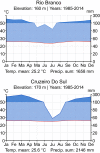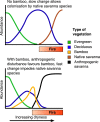Bamboo, climate change and forest use: A critical combination for southwestern Amazonian forests?
- PMID: 31797166
- PMCID: PMC7240005
- DOI: 10.1007/s13280-019-01299-3
Bamboo, climate change and forest use: A critical combination for southwestern Amazonian forests?
Abstract
About 160 000 km2 of forests in the border zone between Brazil and Peru are dominated by semi-scandent bamboos (Guadua spp.). We argue that both predicted decreased precipitation during the dry season and widespread anthropogenic disturbances will significantly increase the distribution and biomass of bamboos in the area. Seasonal dryness favours the growth of evergreen bamboos in relation to trees that shed their leaves during the dry season. Disturbance can be beneficial for the bamboo because, as a clonal plant, it is often able to recover more rapidly than trees. It also withstands dry season better than many trees. The bamboo life cycle ends in a mass mortality event every 28 years, producing potential fuel for a forest fire. Presently, natural forest fires hardly exist in the area. However, in the projected future climate with more pronounced dry season and with increased fuel load after bamboo die-off events the forests may start to catch fire that has escaped from inhabited areas or even started naturally. Fires can kill trees, thus further increasing the fuel load of the forest. As a result, the landscape may start to convert to a savanna ecosystem.
Keywords: Deciduous forest; Fire; Forest management; Guadua; Rain forest.
Figures





Similar articles
-
[Simulating the effects of climate change and fire disturbance on aboveground biomass of boreal forests in the Great Xing'an Mountains, Northeast China].Ying Yong Sheng Tai Xue Bao. 2018 Mar;29(3):713-724. doi: 10.13287/j.1001-9332.201803.011. Ying Yong Sheng Tai Xue Bao. 2018. PMID: 29722211 Chinese.
-
Forest structure and carbon dynamics in Amazonian tropical rain forests.Oecologia. 2004 Aug;140(3):468-79. doi: 10.1007/s00442-004-1598-z. Epub 2004 Jun 17. Oecologia. 2004. PMID: 15221436
-
Climate regime shift and forest loss amplify fire in Amazonian forests.Glob Chang Biol. 2020 Oct;26(10):5874-5885. doi: 10.1111/gcb.15279. Epub 2020 Aug 13. Glob Chang Biol. 2020. PMID: 32662146
-
Paleoecological and historical data as an important tool in ecosystem management.J Environ Manage. 2019 Apr 15;236:755-768. doi: 10.1016/j.jenvman.2019.02.002. Epub 2019 Feb 15. J Environ Manage. 2019. PMID: 30776550 Review.
-
Climate change-induced ecosystem disturbance: a review on sclerophyllous and semi-deciduous forests in Tunisia.Plant Biol (Stuttg). 2023 Jun;25(4):481-497. doi: 10.1111/plb.13524. Epub 2023 May 1. Plant Biol (Stuttg). 2023. PMID: 37014233 Review.
Cited by
-
Impact of anthropogenic disturbance and climate on bamboo distribution in shifting cultivation landscapes of Northeast India.Sci Rep. 2025 Aug 3;15(1):28290. doi: 10.1038/s41598-025-13075-3. Sci Rep. 2025. PMID: 40754588 Free PMC article.
References
-
- Acre. 2006. Zoneamento ecológico-econômico do Acre Fase II: Documento síntese – Escala 1: 250.000. Rio Branco: SEMA.
-
- Alarcón G, Díaz J, Vela M, García M, Gutiérrez J. Deforestación en el sureste de la amazonia del Perú entre los años 1999–2013; caso Regional de Madre de Dios (Puerto Maldonado – Inambari) Revista Investigaciones Altoandinas. 2016;18:319–330.
-
- Almeida CT, Oliveira-Júnior JF, Delgado RC, Cubo P, Ramos MC. Spatiotemporal rainfall and temperature trends throughout the Brazilian Legal Amazon, 1973–2013. International Journal of Climatology. 2016;37:2013–2026. doi: 10.1002/joc.4831. - DOI
-
- Aragão LEOC, Malhi Y, Barbier N, Lima A, Shimabukuro Y, Anderson L, Saatchi S. Interactions between rainfall, deforestation and fires during recent years in the Brazilian Amazonia. Philosophical Transactions of the Royal Society of London B Biological Sciences. 2008;363:1779–1785. doi: 10.1098/rstb.2007.0026. - DOI - PMC - PubMed
MeSH terms
Grants and funding
LinkOut - more resources
Full Text Sources
Medical
Research Materials
Miscellaneous

